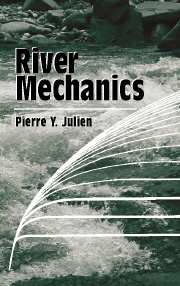Book contents
- Frontmatter
- Contents
- Preface
- Notation
- 1 Introduction to river mechanics
- 2 Physical properties and equations
- 3 River basins
- 4 Steady flow in rivers
- 5 Unsteady flow in rivers
- 6 River equilibrium
- 7 River dynamics
- 8 River stabilization
- 9 River engineering
- 10 Physical river models
- 11 Mathematical river models
- 12 Waves and tides in river estuaries
- Bibliography
- Index
4 - Steady flow in rivers
Published online by Cambridge University Press: 05 June 2012
- Frontmatter
- Contents
- Preface
- Notation
- 1 Introduction to river mechanics
- 2 Physical properties and equations
- 3 River basins
- 4 Steady flow in rivers
- 5 Unsteady flow in rivers
- 6 River equilibrium
- 7 River dynamics
- 8 River stabilization
- 9 River engineering
- 10 Physical river models
- 11 Mathematical river models
- 12 Waves and tides in river estuaries
- Bibliography
- Index
Summary
Steady flow refers to flow conditions that do not change with time. Steady flows can be either uniform when the conditions do not change with space or nonuniform when flow conditions change with space. Steady flow in rivers (Section 4.1) includes description of at-a-station hydraulic geometry, followed by a description of steady-uniform flow and resistance to flow. Steady-nonuniform flows (Section 4.2) include an analysis of the momentum equations followed by rapidly varied flow and gradually varied flow. Sediment transport in rivers (Section 4.3) includes a simple description for sediment transport in steadyuniform flow followed with calculations of aggradation and degradation in river reaches.
Steady river flow
Drainage networks have been studied by geomorphologists and topologists. In general, topologists search mathematical ranking and order among subwatersheds without specific reference to physical entities. The results of several years of experimental studies from the Rainfall Erosion Facility at Colorado State University by Schumm et al. (1987) attempted to relate basin morphology and sediment yield. Although considerable sediment-yield variability is assumed to result from climatic fluctuations and land-use changes, the experiments show that sediment yield is highly variable under steady rainfall conditions. The complex response of channel network evolution seems to be characterized by an exponential decrease in sediment yield as the channel network develops.
Rivers follow the low points along the watershed topographic profiles. With very few exceptions in arid areas, the lowest point of awatershed is located at the river outlet.
- Type
- Chapter
- Information
- River Mechanics , pp. 79 - 121Publisher: Cambridge University PressPrint publication year: 2002



